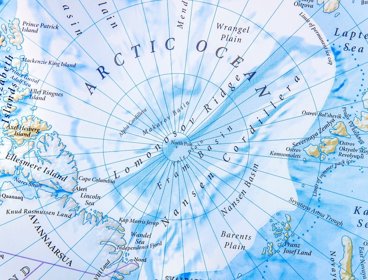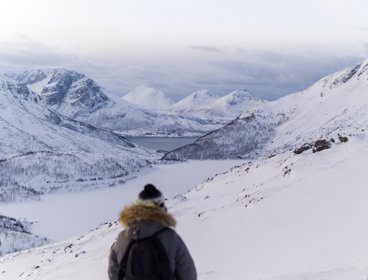The Arctic region
Definitions of the Arctic region vary, but for political purposes the most common definition is the area north of the Arctic Circle, latitude of approximately 66°30’ N.
There are approximately 4 million people living in this circumpolar region, distributed across the eight Arctic states: Norway, Sweden, Finland, Denmark with Greenland, Iceland, Canada, Russia, and the USA. Among these inhabitants, around 10% are Indigenous, with immemorial ties and traditions that often cross today’s state borders.
In this resource, we will examine how the Arctic is governed, and in particular how the Arctic Council functions in light of global geopolitics.
The Arctic is often compared to the Antarctic, but just as the name of the latter suggests, the two are in many ways polar (!) opposites: The Arctic is largely ocean space, surrounded by state territories, while Antarctica is a continent surrounded by ocean. And Antarctica is also governed by The Antarctic Treaty, which uniquely suspends states’ territorial claims – unlike the Arctic, where people live and have done through history. This is arguably one of the most important characteristics to remember about Arctic decision-making, namely that the starting point always needs to be the people living there.

Figure 1 Arctic regions © RGS-IBG
Due to its particular geography, Arctic governance should be understood as a combination of traditional territorial governance by the eight states and their inhabitants, international organisations, and ocean law. The Arctic Ocean is, as all ocean spaces, divided and governed according to the UN Convention of the Sea (UNCLOS). This means that the maritime spaces nearest state territories are theirs to control, and marine resources theirs to harvest in their Exclusive Economic Zone. Beyond 200 nautical miles from the shore, however, countries can claim an ‘extended continental shelf’ with its seabed resources, based on geological data and in accordance with bilateral negotiations with other countries whose claims may overlap. This is a complex process that is still ongoing in many parts of the world – including some parts of the Arctic. However, several oceanic boundary negotiations have been agreed, leading some to point to the Arctic as an ‘exceptional’ example of international cooperation, as we will return to below.
The Arctic Council
The eight Arctic states mentioned above came together to form the Arctic Council in 1996. This is an intergovernmental forum – i.e., an organisation where governments meet, but which does not itself make any decisions – and was in turn based on earlier environmental cooperation between them. Following the first declaration that established the Arctic Council, the Ottawa Declaration (1996), the members and signatories became known as the ‘Arctic states’. It is their representatives (Ministers of Foreign Affairs and Senior Arctic Officials) who come together every second year to discuss and vote on issues; and the chairship rotates between members at the same interval. In addition to state representatives present, there are six Indigenous peoples’ organisations that are ‘permanent participants’ and who will always be consulted prior to voting in the Arctic Council. There are The Aleut International Association, Arctic Athabaskan Council, Gwich'in Council International, Inuit Circumpolar Council, RAIPON (Russian Association of Indigenous Peoples of the North), and Saami Council.

Figure 2 The Arctic Council in Rovaniemi, Finland, in 2019. Often viewed as a model of regional governance and cooperation across the globe, the Arctic Council will have to undergo structural changes if it wants to adapt to the new C21st challenges ahead © Arctic Council via High North News
Other countries, organisations, actors, and stakeholders can become ‘observers’ to the Council – among these are the United Kingdom, China, WWF, and many more. While their role in ministerial meetings is, indeed, to observe, they can contribute to the Arctic Council’s scientific working groups. And the role of science and research is significant in Arctic relations – political decisions are to be based on the evidence presented, and cooperation between states happens in the name of science. Moreover, taking part in the Arctic Council even as an observer means also taking part in international politics – in other words, it can be an important forum for actors to be involved, in the same room as for example the USA and China.
Having considered above some of the defining features of Arctic governance, a topic that often makes headlines in newspaper is that of Arctic geopolitics – namely how the region’s geography impacts politics and vice versa. Many assume that geopolitics refers only to inter-state affairs, but as will be clear geography and politics interact at many scales – from the personal to international. And considering a circumpolar region of numerous countries, peoples, and cultures it is ever more important to look beyond the headlines to appreciate the complexities of power relations in and of the region.
Arctic geopolitics: conflict and cooperation
When discussing Arctic geopolitics, there are often two opposing narratives that tend to dominate: Either the Arctic is presented as a space of imminent threat and danger or as an exceptional space of peace and cooperation. We will look at each in turn below in order to identify aspects of each that we may or may not agree with.
Arctic conflict
First, it is important to note that stories of Arctic danger are not new. At the time of exploration and colonisation, Western explorers travelled north to prove their strength in the face of inhospitable climates. Tales of polar bears, ice and snow, and even ghostly hauntings travelled back to imperial centres, painting a picture of danger and intrigue.
These imaginaries of the region were of course not shared among its inhabitants, but their stories of Arctic vitality have often not been heard in capitals and among those in power.
Today, aspects of these narratives persist through stories of contemporary ‘explorers’ and sportspeople, through technological innovation that is meant to ‘conquer’ the elements and harvest its resources, and through defence and security concerns of the High North.
In hearing these stories, it is often worth taking pause to identify the protagonist in the plot: Whose purpose does it serve, and what is it trying to tell us?
Arctic cooperation
Second, stories of the Arctic as a space of peaceful cooperation between otherwise hostile states and distant peoples have been referred to as ‘Arctic exceptionalism’. While experts have worked as hard to dispel this myth as that above, some still believe that Arctic relations can and should be shielded from geopolitics elsewhere. What these imaginaries of the region highlight is the genuinely unique mechanisms of the Arctic Council – including not only the recent cooperation of e.g. Russia and the USA, but also the inclusion of Indigenous peoples at the table. They point to the resilience of the region in spite of colonial exploitation and environmental changes; and they point to the great strides that have been made in international cooperation and agreements. As in the above narrative, we may want to consider what outcomes and decisions these narratives may lead us to – and what might be overlooked?
Arctic governance and global geopolitics
Clearly both a view of the Arctic region as one inherently and exclusively of something negative and of something positive are too simplistic. As with any geographical region, it is the home of a multitude of visions, pasts, and possible futures – much of which have yet to decided by us.
One thing that has become increasingly clear in recent months, however, is that Arctic geopolitics cannot be understood in isolation – no matter the goodwill, and no matter the belief in exceptionalism, conflicts elsewhere are also felt in the High North. After Russia’s invasion of Ukraine in 2022, the Arctic Council for the first time paused their activities. The intergovernmental forum that has been able to continue to work despite other conflicts and challenges, was finally forced to react to global geopolitics. Russia held the chairship at the time, and in May 2023 this was handed over to Norway – for the first time, the handover took place virtually without the usual ministerial meeting. This is of course significant for diplomacy and inter-state work, but perhaps even more seriously it limits the aforementioned unique role of Indigenous peoples. For Indigenous peoples living across state borders, the closures and pauses come with an added worry about people-to-people contact. And for the efforts of working groups, important scientific and climatic data are not being shared as previously – meaning that the picture of the circumpolar region now has holes.
While it is impossible to predict the future, actors in Arctic governance and geopolitics have expressed a strong desire to continue the positive work highlighted in the second geopolitical vision. Unlike international politics, climate change does not pause when relations elsewhere impede human interaction – and this, in the end, is the challenge that we will all face both in the Arctic and beyond.
Further reading
- The Arctic Council Who we are
- High North News Has the Arctic Council become a paper polar bear – outwardly powerful, but inwardly ineffectual?
- Foreign Policy The Rise and Sudden Fall of the Arctic Council
- The Guardian Editorial The Guardian view on the Arctic: threatened by Putin’s war
- The Arctic Institute The Arctic Council in Transition: Challenges and Perspectives for the new Norwegian Chairship
- i News US opens diplomatic post in northern Norway as world powers fight for their share of the Arctic
- Bloomberg Russia Hands Arctic Council Chair to Norway in Low-Key Ceremony
- The Independent Norway takes over presidency of Arctic Council from Russia



